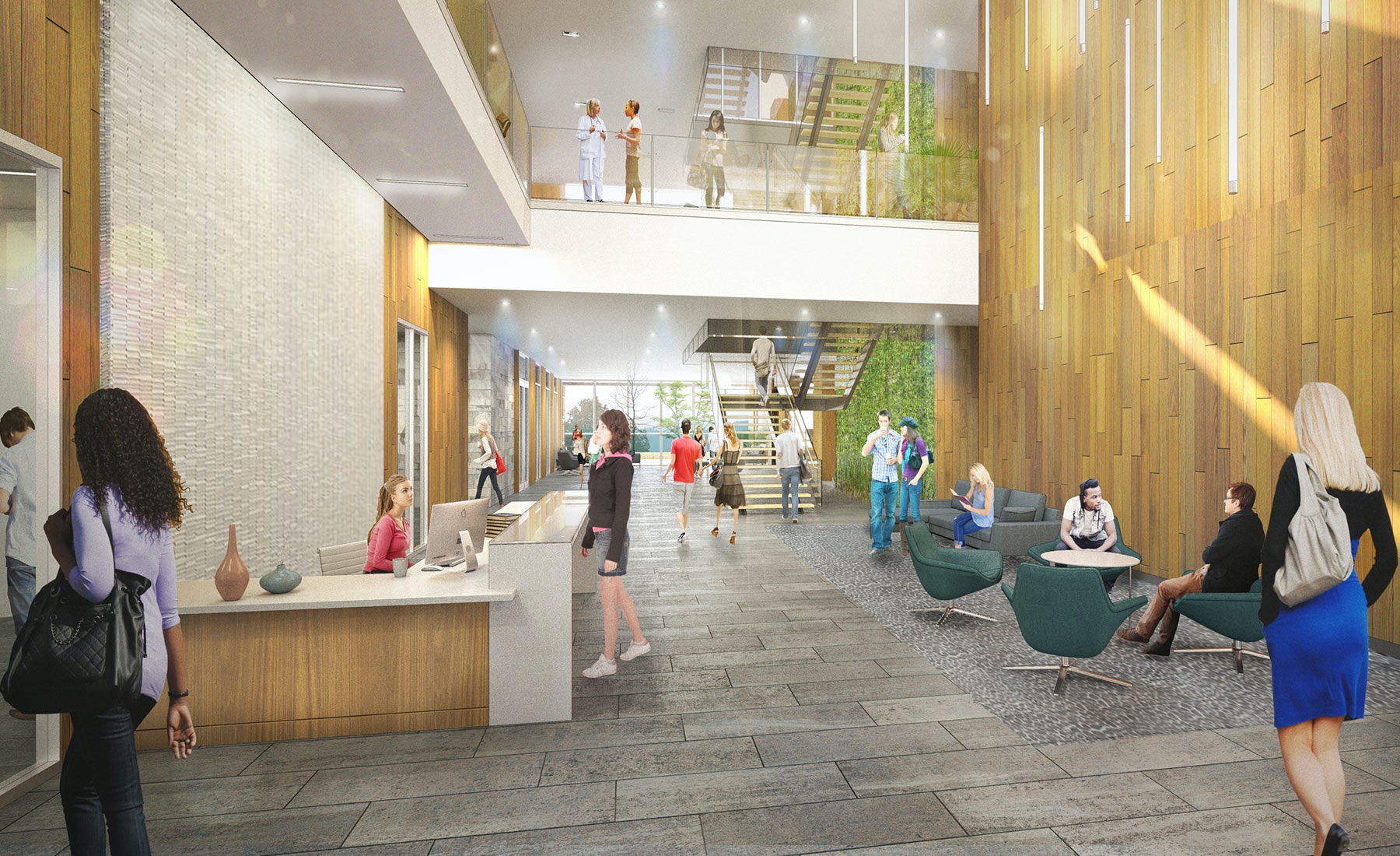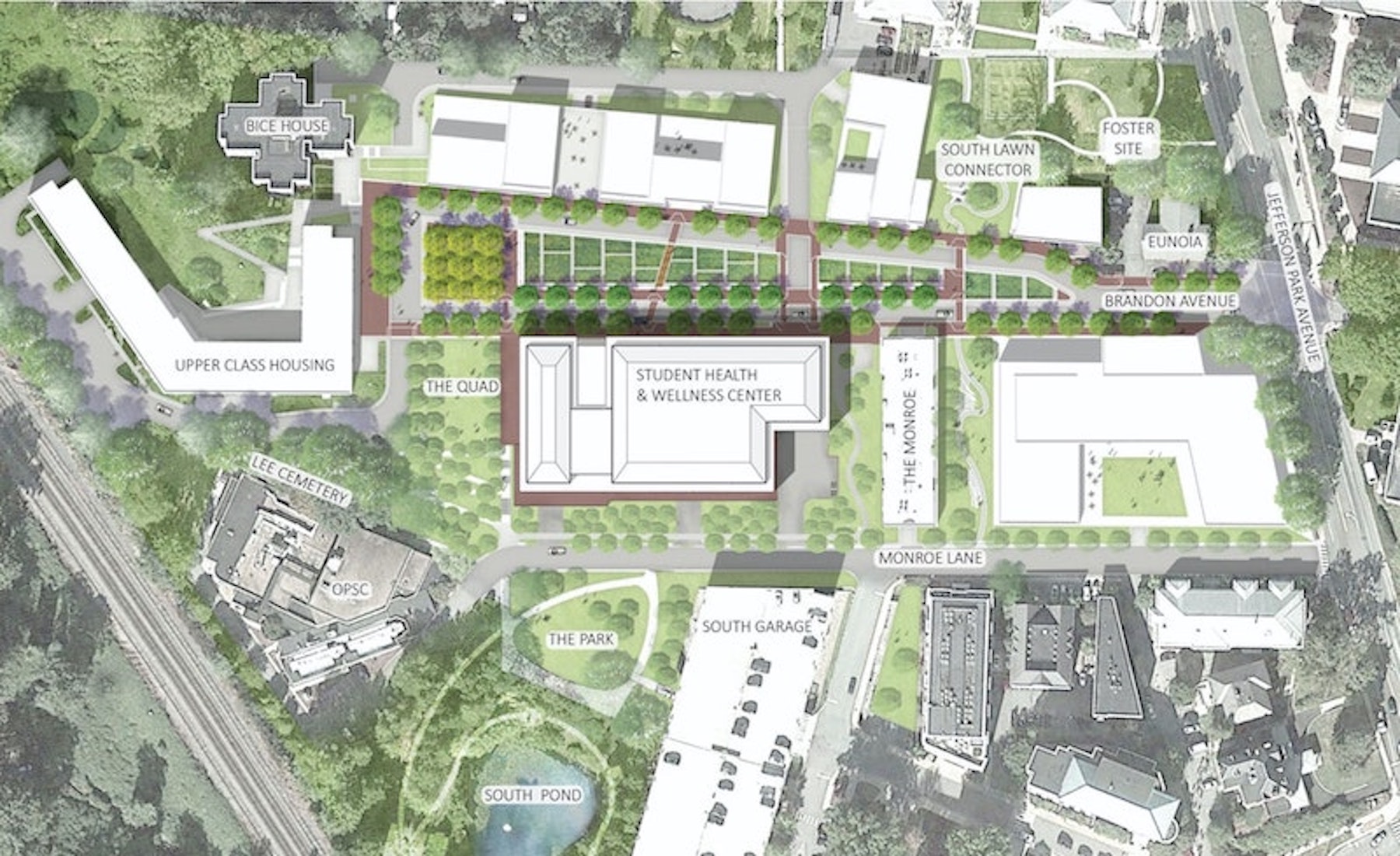Buildings offering wellness services are proliferating on college campuses.
Among the schools with student centers that include “wellness” in their titles and programming are Franklin & Marshall College, the University of Chicago, Cal State Fullerton, Texas Tech, Stevens Institute of Technology, College of the Holy Cross, New York University, the University of Utah, Duke University, and Rutgers University.
Wellness “is redefining the typology,” says Scott Baltimore, an architect with Duda|Paine Architects in Durham, N.C., which has carved out a specialty in wellness design. He elaborates that more schools are taking a “synergistic” approach that brings different services and academic departments under one roof, thereby making the building more of a destination.
This transformation has also been “institutional,” says Turan Duda, FAIA, the firm’s Founding Principal. Parents want to know where their kids can go if their educational journey suffers a medical or psychological setback, particularly in the area of depression. More to the point, says Duda, are the “preventive” services that wellness suggests, a “safe place” where students can turn to for help and interaction.
AN EVOLVING FIELD
That colleges and universities are using wellness centers as part of their marketing and recruiting isn’t surprising. But what constitutes “wellness” depends on the school, and can be intentionally ambiguous, says Duda, because “this field is evolving.” To cite one unusual example, Duke University attracted more male students to its wellness center only after it introduced a “drumming circle” to its programming.
One of Duda|Paine’s projects is the recently completed University of Virginia Student Health & Wellness Center in Charlottesville, which the firm designed in collaboration with WMDO Architects, a frequent partner with the university. The project’s construction manager was Barton Malow, and the building pursued the International WELL Building Institute’s WELL Building Standard certification.
This 169,000-sf building, which replaces the school’s Elson Student Health Center, emphasizes wellness and preventive healthcare. It integrates student life and healthcare by introducing students to critical aspects of social, physical, psychological, personal, and environmental wellness. The project also brings together all the major campus health departments—General Medicine, Gynecology, Counseling and Psychological Services, Office of Health Promotion, and the Student Disability Access Center—as well as the Kinesiology Department and student wellness spaces.
During the building’s design phase, WMDO conducted workshops that included a virtual-reality simulation of the center’s entrance to assess different scenarios of student well-being. Another workshop focused on “journey mapping.”
The resulting four-story building is organized around an open and light-filled entry and multi-story lobby, with generous daylighting into all departments, and improved orientation and wayfinding. On the ground floor, level with the exterior ground plane to optimize visibility and accessibility, the Office of Health Promotion presents the “first stop” for students, while the Student Disability Access Center is convenient and central, overlooking the south pond.

PART OF A LARGER MASTER PLAN
Spaces on the ground level create opportunities for program synergies and community outreach. These include a pharmacy and retail space, and a teaching kitchen that provides classes on healthy eating habits and nutrition. (Duda sees this kitchen as another of the center’s “preventive” services. “Wellness centers are giving special attention to experiences,” says Duda, from the parking lot to the “choices” in services the center makes available to students.)
An Education/Multi-Purpose space adjacent to the main lobby supports functions such as yoga, special events, staff meetings, and wellness education. These spaces facilitate interaction and the exploration of alternative methodologies in wellness education.

The University of Virginia’s Student Health & Wellness Center is located close to the school’s historic quad. The building is also the first development within the Perkins and Will-designed Brandon Avenue Precinct Master Plan that eventually will include housing and other mixed-use buildings along a “green street,” and weave the university’s Central Grounds and the Health System Campus.
Related Stories
| Mar 3, 2011
HDR acquires healthcare design-build firm Cooper Medical
HDR, a global architecture, engineering and consulting firm, acquired Cooper Medical, a firm providing integrated design and construction services for healthcare facilities throughout the U.S. The new alliance, HDR Cooper Medical, will provide a full service design and construction delivery model to healthcare clients.
| Mar 1, 2011
New survey shows shifts in hospital construction projects
America’s hospitals and health systems are focusing more on renovation or expansion than new construction, according to a new survey conducted by Health Facilities Management magazine and the American Society for Healthcare Engineering (ASHE). In fact, renovation or expansion accounted for 73% of construction projects at hospitals responding to the survey.
| Feb 22, 2011
HDR Architecture names four healthcare directors
Four senior professionals in HDR Architecture’s healthcare program have been named Healthcare directors.
| Feb 17, 2011
HDR Architecture sponsors national effort to green operating rooms
HDR Architecture, Inc. has joined the group of corporate sponsors of Practice Greenhealth’s Greening the Operating Room Initiative. This sweeping and prescriptive path to green the nation’s operating rooms was launched earlier this year to reduce the environmental footprint of the operating suites in hospitals across the country, which can produce between 20 and 30% of a hospital’s total waste.
| Feb 11, 2011
Iowa surgery center addresses both inpatient and outpatient care
The 12,000-person community of Carroll, Iowa, has a new $28 million surgery center to provide both inpatient and outpatient care. Minneapolis-based healthcare design firm Horty Elving headed up the four-story, 120,000-sf project for St. Anthony’s Regional Hospital. The center’s layout is based on a circular process flow, and includes four 800-sf operating rooms with poured rubber floors to reduce leg fatigue for surgeons and support staff, two substerile rooms between each pair of operating rooms, and two endoscopy rooms adjacent to the outpatient prep and recovery rooms. Recovery rooms are clustered in groups of four. The large family lounge (left) has expansive windows with views of the countryside, and television monitors that display coded information on patient status so loved ones can follow a patient’s progress.
| Feb 11, 2011
Two projects seek to reinvigorate Los Angeles County medical center
HMC Architects designed two new buildings for the Los Angeles County Martin Luther King, Jr., Medical Center as part of a $360 million plan to reinvigorate the campus. The buildings include a 120-bed hospital, which involves renovation of an existing tower and several support buildings, and the construction of a new multi-service ambulatory care center. The new facilities will have large expanses of glass at all waiting and public areas for unobstructed views of downtown Los Angeles. A curved glass entrance canopy will unite the two buildings. When both projects are completed—the hospital in 2012 and the ambulatory care center in 2013—the campus will have added more than 460,000 sf of space. The hospital will seek LEED certification, while the ambulatory care center is targeting LEED Silver.
| Feb 9, 2011
Hospital Construction in the Age of Obamacare
The recession has hurt even the usually vibrant healthcare segment. Nearly three out of four hospital systems have put the brakes on capital projects. We asked five capital expenditure insiders for their advice on how Building Teams can still succeed in this highly competitive sector.
| Jan 31, 2011
Cuningham Group Architecture launches Healthcare studio with Lee Brennan
International design firm Cuningham Group Architecture, P.A. (Cuningham Group) has announced the arrival of Lee Brennan, AIA, as Principal and Leader of its new Healthcare studio. Brennan comes to Cuningham Group with over 30 years of professional experience, 22 of those years in healthcare, encompassing all aspects of project delivery, from strategic planning and programming through design and construction. The firm’s new Healthcare studio will enhance Cuningham Group’s expertise in leisure and entertainment, education, mixed-use/housing and workplace environments.
| Jan 31, 2011
HDR Architecture Releases Evidence-based Design Videos
As a follow-up to its book Evidence-based Design for Healthcare Facilities, HDR Architecture, Inc. has released three video case studies that highlight evidence-based design principles in action.










